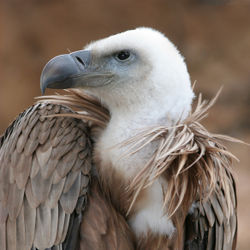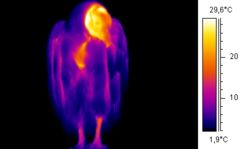|
Vultures |

Griffon vulture, Gyps fulvus
|
|
Scientific classification |
| Kingdom: |
Animalia
|
| Phylum: |
Chordata
|
| Class: |
Aves
|
|
| Orders |
Falconiformes (Fam.
Accipitridae (part))
Ciconiiformes (Fam.
Cathartidae) |
Vultures are
scavenging
birds, feeding mostly on the carcasses of dead
animals. Vultures are found in every continent except
Antarctica and Oceania.
A particular characteristic of many vultures is a bald
head, devoid of
feathers. This is likely because a feathered head would
become spattered with
blood and other fluids, and thus be difficult to keep
clean. This feature also allows quick cleaning in a nearby
river.
Vultures fall into two groups. The
Old World vultures found in Africa, Asia and Europe belong to the family
Accipitridae, which also includes
eagles,
kites,
buzzards and
hawks. They find carcasses exclusively by sight.
New World vultures and
condors are not at all closely related to the
superficially similar Accipitridae, but belong in the family
Cathartidae, which is quite close to the
storks. Several species have a good sense of smell,
unusual for
raptors.
The similarities between the two groups are due to
convergent evolution rather than a close relationship.
A group of vultures is occasionally called a venue.
When circling in the air, a group of vultures is called a
kettle.
Feeding

Some members of both the old and new world
vultures have an unfeathered neck and head,
shown as radiating heat in this thermographic
image.
Vulture seldom attack a healthy living animal, but may
kill the wounded or sick. Vast numbers have been seen upon
battlefields. They gorge themselves when prey is abundant,
till their
crop forms a projection, and sit, sleepy or half torpid,
to digest their food. They do not carry food to their young
in their claws, but disgorge it from the crop. These birds
are of great value as scavengers, especially in hot regions.
Threat due to diclofenac poisoning
The vulture population in
India has declined by up to 95% recently and two or three of
the species of vulture in South Asia are nearing extinction.
The cause was found to be due to the practice of giving
working animals the non-steroidal anti-inflammatory drug (NSAID)
diclofenac, which has a pain killing action. Diclofenac
administration keeps animals that are ill or in pain working
on the land for longer. Diclofenac accumulates in the
animals' bodies; when the ill animals die, their carcasses
will still contain the diclofenac. Farmers leave the dead
animals out in the open, relying on vultures to tidy up.
Diclofenac present in carcasses it also eaten by the
vultures, but unfortunately vultures are very sensitive to
diclofenac and suffer kidney failure and death as a result
of diclofenac poisoning.
The decline has led to general hygiene problems in India
as carcasses of dead animals now tend to rot, or be eaten by
rats or wild dogs, rather than be tidied up by vultures. In
addition, there are particular problems for certain human
communities, such as the Parsi, that have sky burials where
the human dead are put on the top of Towers of Silence where vultures eat and clean the
bodies and leave only dry bones.
Meloxicam – another NSAID similar to diclofenac – has
been found to be harmless to vultures and should prove to be
an acceptable alternative. The Government of India has
banned diclofenac, but it continues to be sold over a year
later.
Vultures in culture
Ancient Egypt
In Southern Africa, the name for a
Nubian Vulture is synonymous with the term applied to
lovers, because these vultures are always seen in pairs,
mother and child remaining closely bonded together. Pairing,
bonding, protecting, and loving are essential attributes
associated with a vulture. The vulture was thought to be
close to the gods who resided in the sky because of its
immense size and its ability to soar high up in the sky. The
Egyptians considered the vulture to be an excellent mother,
and its wide wingspan was seen as all-encompassing and
providing a protective cover to its infants. The vulture
hieroglyph
was the uniliteral used for the glottal sound (3)
including words such as mother, prosperous,
grandmother, and ruler.
Western culture
In contrast to many other birds of prey, vultures have
often been considered repulsive in Western culture, due to
their association with death. Sensationalistic journalists
looking for news about bloody crimes are sometimes called
"vultures". Financial investors who look for indebted
companies or countries to buy securities at low prices are
known as vulture funds. Lawyers who profit off death, such
as inheritance, wrongful death, or life insurance lawyers,
may also be called "vultures". A prominent Spider-Man
supervillain is known as the Vulture.
See also
- "India's Vultures Fall Prey to a Drug in the Cattle
They Feed On", New York Times, Amelia Gentleman, March
28, 2006.
External links




